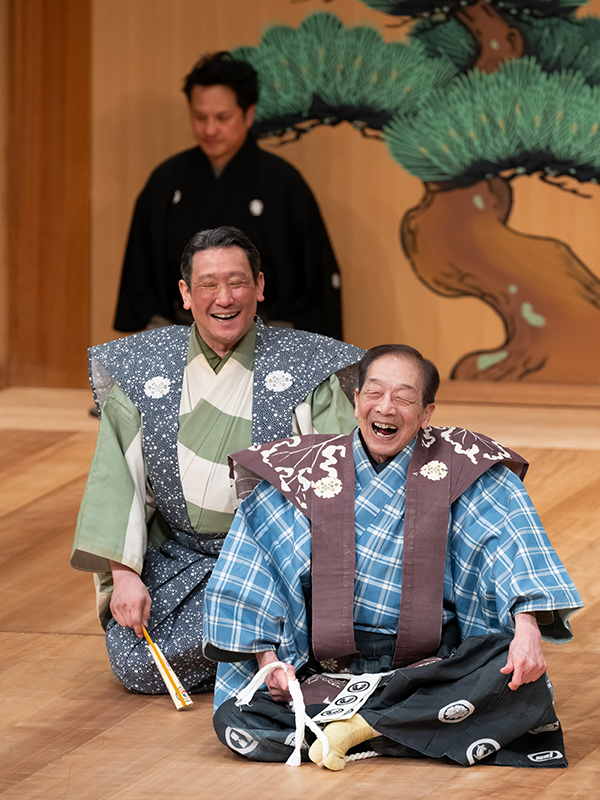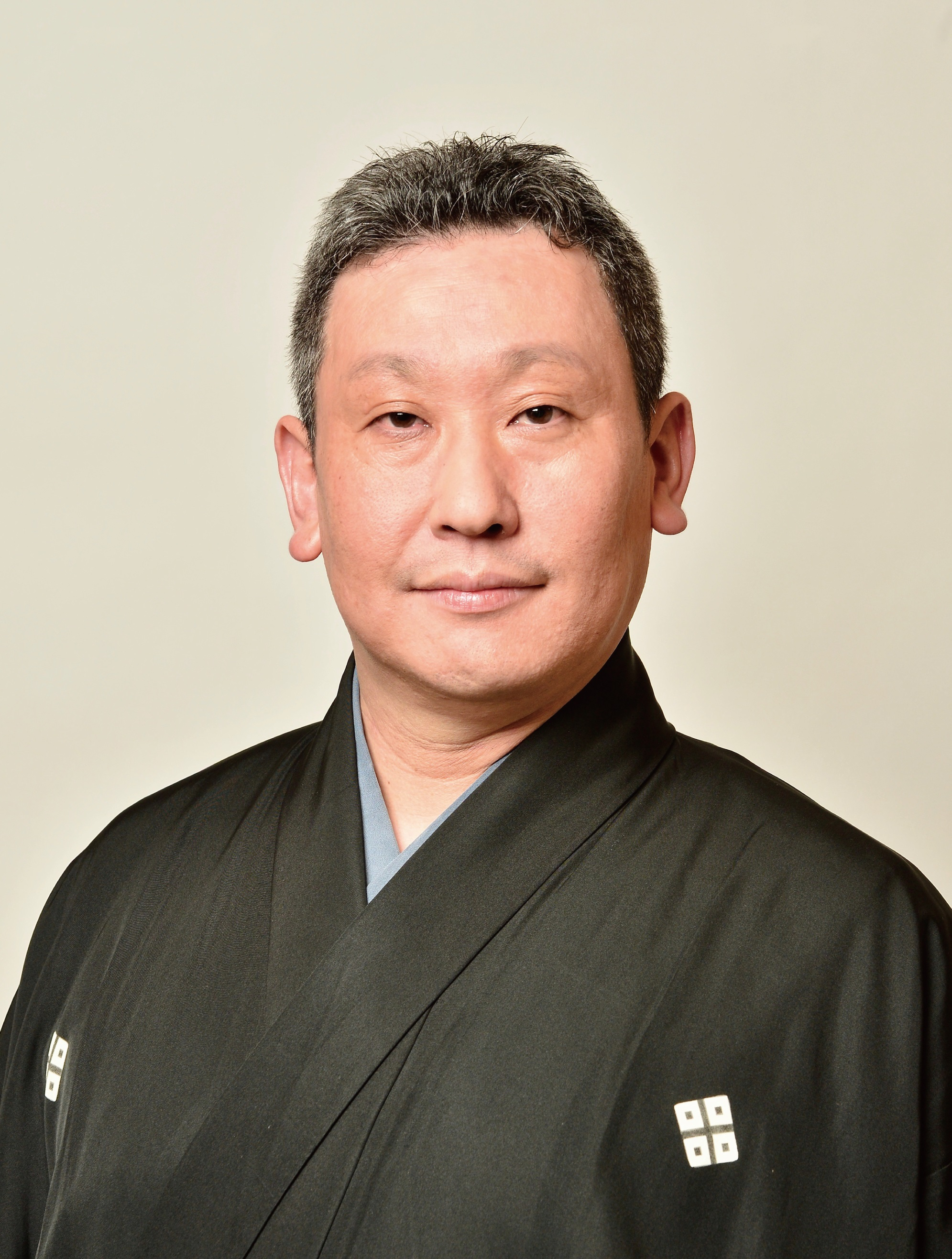An Evening of Noh and Kyogen 2025
Every year in autumn, the Japan Foundation Kyoto Office organizes an event called “An Evening of Noh and Kyogen” to give people an opportunity to experience traditional Japanese culture, inviting international students, the Japan Foundation Fellows, and those enrolled at the Japanese-Language Institute, Kansai to join us.
| Date and time | Friday, November 21, 2025 from 6:30 p.m. (Doors will open at 6:00 p.m.) |
|---|---|
| Venue | Kongo Noh Theatre (karasuma-nakadachiuri, kamigyo-ku, Kyoto) Tel: +81-(0)75-441-7222 ※Flyer:An Evening of Noh and Kyogen 2025 (PDF:17MB) |
| Program |
<Kyogen> <Noh> |
| Organizers | The Japan Foundation Kyoto Office The Japan Foundation Japanese Language Institute, Kansai |
| Collaboration | The Kongo Noh Theatre Foundation Shigeyama Kyogen Troupe Art Research Center, Ritsumeikan University |
| Endorsement | Kyoto Prefecture, Kyoto City, Kyoto City Tourist Association, The Kyoto Shimbun Co., Ltd, Kyoto Arts and Culture Foundation |
| Admission Fees (all free seating) |
¥3,500 (students: ¥2,000) |
| Tickets will be Available from Friday, September 19 at |
Kongo Noh Theatre |
Programme Synopsis
Kyogen:Nawanai (Rope-Twisting)

A master loses a fortune at the gaming table and pledges his servant, Taro Kaja, as collateral for his debts.Taro Kaja is sent off—without explanation—to a certain person who bested his master. When he learns he has been put up as collateral for his master’s debts, he takes offense and flatly refuses to work. Enraged, the new master complains to the old master, who then sends Taro Kaja home to demonstrate his true work ethic under ordinary circumstances. Overjoyed at the prospect of returning to his master, Taro Kaja rushes home and begins twisting rope as instructed. While he works, he gleefully speaks ill of the new master’s household. Meanwhile, his master, holding the other end of the rope, quietly slips away, and the new master takes his place—though Taro Kaja never even notices.
The rope-twisting scene—rich with gestures and mimicry—is a solo performance by the principal actor and one of the work’s most memorable highlights.
<Kyogen>
Kyogen is a form of comic theater that emerged during Japan’s Muromachi period (around 1336 to 1573) and developed alongside Noh. It traces its origins to “Sarugaku,” a form of Japanese entertainment dating back to the late Heian period (mid-12th century). Later, the term “Nohgaku” was created to encompass these twin arts of Noh and Kyogen. While Noh is a tragic musical play, Kyogen is a comedy based on spoken dialog and wordplay. Performed as an interlude between acts of the more solemn Noh play, Kyogen creates comic relief, inducing laughter from the audience like a circus clown.
Stories of blunders in everyday life or making fun of the little quarrels among couples are the favorite motifs of Kyogen, a laughter theme unchanging even in modern days. Kyogen is a universal form of art that has made people laugh for centuries and will for centuries to come.
Noh: TSUCHI-GUMO (The Ground Spider)

Noh theatre, largely shaped into form by the father-and-son duo Kan’ami and Zeami during the Muromachi period (1336–1573), focuses on a single principal role (the shite) and the subtleties of that character’s inner life. Over time, playwrights created a wide range of works, some of which were—like Tsuchigumo—dynamic and spectacular.
Our story unfolds in mid-Heian Japan, when the samurai general Minamoto no Raiko (948–1021) lies confined to bed with illness. His maid, Kocho, brings medicine and offers gentle solace to her ailing lord before leaving.
Late that night, after all the retainers have withdrawn, a strange-looking figure in priestly guise (the shite) drifts into the chamber and inquires about Raiko’s health. Suspicious, Raiko demands, “Who are you?” The spirit recites ancient verse, declares itself the source of his malady, and flings a thousand silken strands to entangle him. Raiko seizes his sword Hizamaru from the bedside and slashes at the odd being—but it melts into thin air. Alarmed by the commotion, a stout warrior (the waki, supporting role) rushes in. When Raiko recounts the eerie encounter, the warrior vows to slay the spider-monster incarnate and follows a trail of blood in pursuit.
After the warrior’s servant recounts what transpired, the scene shifts to an old mound. There, the warrior and his men stand before the mound and begin to break it apart. From within appears the earth-spider spirit (the shite), hurling a thousand strands of spider silk in a furious assault. Yet the warrior and his men cleave the creature and bring it down, restoring order and concluding the play.
<Noh>
Noh is a form of theater that emerged during the Muromachi period (1336-1573), brought to its perfection by the father-and-son team of Kanami and Zeami, and since performed countless times to this day. It is a mask drama, but not all performers are masked. Masks are worn only by the main character (shite) and the attendant (tsure). When the main character is not masked, the face is kept completely expressionless, as if wearing a mask. Unlike other forms of theater, Noh does not use scenery or intricate props. Simple props (tsukurimono) sometimes used in Noh plays are intended to be more symbolic than realistic. Noh integrates elements such as masks and simple props in a dance-based performance, inviting viewers to unleash their imaginations and immerse themselves in the world created onstage. In Noh, dialogue is sparse. Rather, Noh sequences highlight the narrative of the main character, incorporating elements of poetry. Since Noh traces its origins to religious rites, many Noh sequences feature a deity in the lead role. This category of Noh is termed “god plays” (kami-noh or waki-noh). Noh plays can be divided into five categories: god plays, warrior plays (shura-noh), women plays (kazura-noh), miscellaneous plays (zatsu-noh), and demon plays (oni-noh or kiri-noh). Of the five categories, the warrior plays center on a warrior who, after a lifetime of battle, is condemned to wander in Warrior Hell, a world of eternal struggle within Buddhist philosophy. The women plays feature a female protagonist from the literature of the Imperial Court, embodying Zeami’s concept of yugen, an aesthetic term suggesting quiet elegance and subtle beauty.
Profile
SHIGEYAMA Sengoro

Born in 1972. Eldest son of Shigeyama Sensaku V. Birth name Masakuni.
First appeared on stage at the age of three as the protagonist of “Iroha.” Subsequently led such projects as the Hanagata Kyogen Kai, the Kyogen Shogekijo, “TOPPA!,” and the Kokoromi no Kai in his efforts to win new fans not just for Kyogen but also for Noh theater itself. Currently, he is working to communicate the appeal of Kyogen to a wider age-range of audiences by leading such projects as the Shigeyama Kyogen Kai, the “Cutting Edge KYOGEN” group (a revamped Hanagata Kyogen Kai), the Kashizuki no Kai in partnership with his younger brother, Shigeru, and the Waraenai Kai in partnership with Rakugo specialist Katsura Yonekichi. He has also actively collaborated with artists in other theatrical genres, including Yan Qinggu of the Shanghai Jingju Theatre Company and the Sichuan opera face changing master Jiang Peng. Succeeded to Shigeyama Sengoro XIV in 2016. Recipient of the Agency for Cultural Affairs’ New Artist Award of the National Arts Festival in 2005, recipient of Kyoto Prefectural Culture Award’s Encouragement Prize in 2008 and Distinguished Service Prize in 2025.
KONGO Hisanori

Born in Kyoto in 1951 as the eldest son of Kongo Iwao, the 25th-generation head of the lineage, Hisanori trained under his father from an early age. In September 1998, he became the 26th-generation head of the Kongo school of Noh, and in May 2005 oversaw the completion of the relocation of the Kongo Noh Theatre to the west side of Kyoto Imperial Palace.
Along with “Mai-Kongo” (Dance Kongo), an ornate and dynamic style of acting unique to the Kongo school, he also specializes in the graceful and elegant style known as “Kyo-Kongo” (Kyoto-style Kongo) and is the only head of any of the five shite-kata schools of Noh to be based in the Kansai area. Beginning with his turn as director of the troupe that staged the Kongo school’s inaugural overseas performances in Canada and the United States, he has a wealth of overseas performing experience in countries such as Italy, France, Spain, Portugal, and Russia.
A recipient of the Kyoto Municipal New Artist Award and the Kyoto Prefectural Culture Award’s New Artist Prize and Distinguished Service Prize, he has also been honored with a Cultural Merit Award by the city of Kyoto. He is the recipient of the 67th Minister of Education, Culture, Sports, Science and Technology’s Art Encouragement Prize and in 2018 was awarded the Medal with Purple Ribbon, which is conferred by the Government of Japan to individuals who have contributed to academic and artistic developments. In 2023, he received the Imperial Prize and the Japan Art Academy Prize, and he was designated as a Living National Treasure for each of the important intangible cultural properties of Nohgaku. He was awarded the Officer of the Order of Arts and Letters of France.
As well as serving as President of the Kongo Nohgakudo Foundation, President of the Kongo Nohgaku-kai, President of the Kongo-kai, and Chairman of the Nihon Nohgaku-kai, he is also a visiting professor at the Kyoto City University of Arts and the author of Kongo-ke no men [Masks of the Kongo Lineage] and Kongo soke no noh-men to noh-shozoku [Noh Masks and Noh Costumes of the Kongo Lineage].
[Contact Us]
The Japan Foundation Kyoto Office
(3rd Floor, Kyoto International Community House 2-1 Torii-cho, Awataguchi, Sakyo-ku, Kyoto)
Tel: +81-(0)75-762-1136
- About Us Top
- About the Japan Foundation
- Donations
- News & Topics
- News & Topics Top
- Main Activities
- Main Activities Top
- Fiscal Year 2025-2026
- Fiscal Year 2024-2025
- Fiscal Year 2023-2024
- Fiscal Year 2022-2023
- Fiscal Year 2021-2022
- Fiscal Year 2020-2021
- Fiscal Year 2019-2020
- Fiscal Year 2018-2019
- Fiscal Year 2017-2018
- Fiscal Year 2016-2017
- Fiscal Year 2015-2016
- Fiscal Year 2014-2015
- Fiscal Year 2013-2014
- Events / Projects
- Press Release
- Press Release Top
- Fiscal Year 2025-2026
- Fiscal Year 2024-2025
- Fiscal Year 2023-2024
- Fiscal Year 2022-2023
- Fiscal Year 2021-2022
- Fiscal Year 2020-2021
- Fiscal Year 2019-2020
- Fiscal Year 2018-2019
- Fiscal Year 2017-2018
- Fiscal Year 2016-2017
- Fiscal Year 2015-2016
- Fiscal Year 2014-2015
- Fiscal Year 2013-2014
- Links
